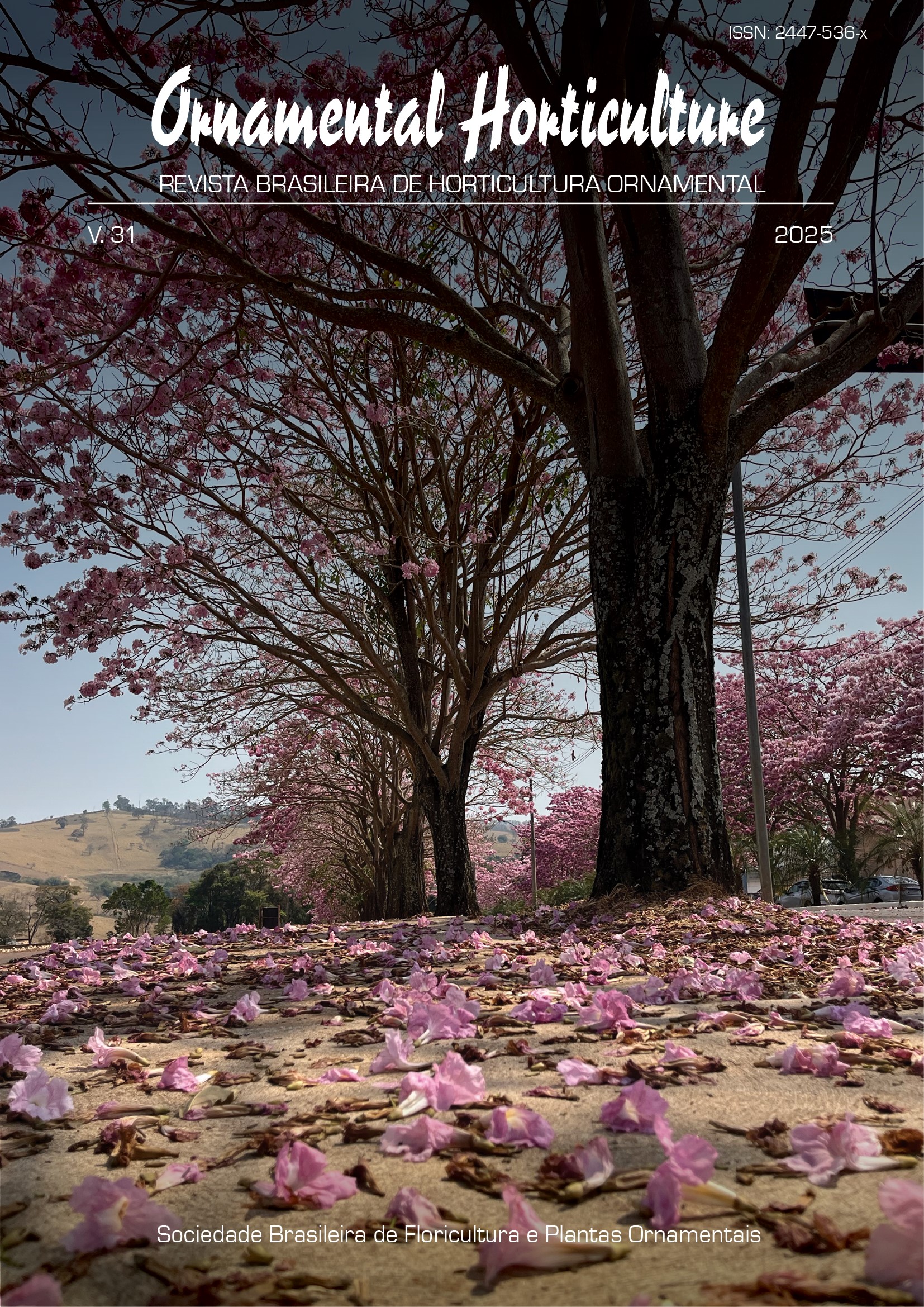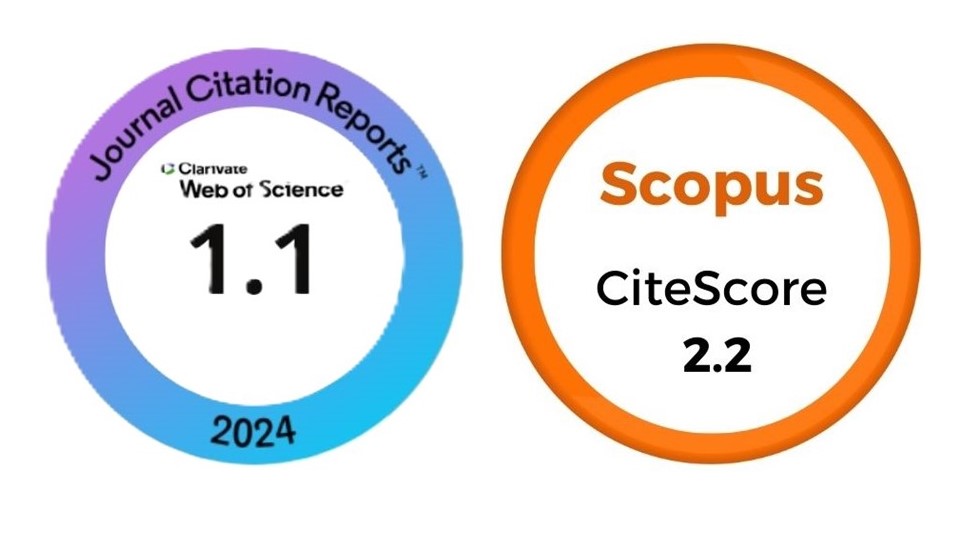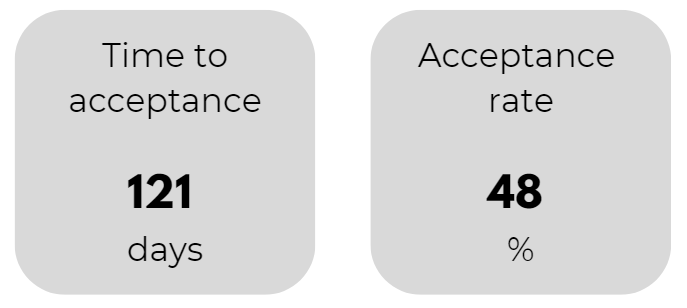Fulvic acid improves morphophysiological traits and vase life in Alstroemeria ‘Orange Queen’ in soilless conditions
DOI:
https://doi.org/10.1590/2447-536X.v31.e312802Keywords:
Biochemical traits, Biostimulant, Flowering indices, Photosynthetic pigments, Vase lifeAbstract
The application of fulvic acid as a biostimulant was investigated for its effects on flowering indices, biochemical traits, and vase life of Alstroemeria ‘Orange Queen’. Conducted in a controlled greenhouse setting, the study employed fulvic acid concentrations of 50, 100, and 200 mg l⁻¹ as drench. Results demonstrated significant improvements in various flowering parameters. Notably, the 100 mg l⁻¹ concentration increased bud diameter and length, and enhanced floret fresh and dry weight compared to the control. Additionally, this concentration significantly elevated chlorophyll a, b, and total chlorophyll contents, as well as carotenoid and anthocyanin levels, thus improving photosynthetic efficiency and flower pigmentation. Soluble sugars in leaves and petals also increased with fulvic acid application, particularly at 100 mg L⁻¹, indicating enhanced carbohydrate accumulation. Furthermore, fulvic acid treatment prolonged the vase life of cut flowers, with the 100 mg l⁻¹ concentration achieving the most substantial extension. The observed improvements in growth, pigment content, and flower longevity suggest that fulvic acid acts as a potent biostimulant, optimizing both aesthetic and physiological traits in Alstroemeria. This study highlights the potential of fulvic acid in enhancing ornamental plant quality and proposes further research to explore its long-term effects on other species and horticultural practices.
Downloads
References
AHMAD, S.; KHAN, J.A.; JAMAL, A. Response of pot marigold to different applied levels of humic acid. Journal of Horticulture and Plant Research, v.5, p.57-60, 2019. https://doi.org/10.18052/www.scipress.com/jhpr.5.57.
ALSUDAYS, I.M.; ALSHAMMARY, F.H.; ALABDALLAH, N.M.; ALATAWI, A.; ALOTAIBI, M.M.; ALWUTAYD K.M.; ALHARBI, M.M.; ALGHANEM S.M.S.; ALZUAIBR, F.M.; GHARIB, H.S.; AWAD-ALLAH, M.M.A. Applications of humic and fulvic acid under saline soil conditions to improve growth and yield in barley. BMC Plant Biology, v. 24, n.1, p.191, 2024. https://doi.org/10.1186/s12870-024-04863-6.
AMPONG, K.; HILAKARANTHNA, M.S.; GORIM, L.Y. Understanding the role of humic acids on crop performance and soil health. Frontiers in Agronomy, v.4, p.848621, 2022. https://doi.org/10.3389/fagro.2022.848621.
BALTAZAR, M.; CORREIA, S.; GUINAN, K.J.; SUJEETH, N.; BRAGANCA, R.; GONCALVES, B. 2021. Recent advances in the molecular effects of biostimulants in plants: An overview. Biomolecules, v.11, n.8, p.1096, 2021. https://doi.org/10.3390/biom11081096.
BAYAT, H.; SHAFIE, F.; AMINIFARD, M.H.; DAGHIGHI, S. Comparative effects of humic and fulvic acids as biostimulants on growth, antioxidant activity and nutrient content of yarrow (Achillea millefolium L.). Scientia Horticulturae, v.279, p.109912, 2021. https://doi.org/10.1016/j.scienta.2021.109912.
BRIDGEN, M.P. Alstroemeria. In: Van Huylenbroeck, J. (eds) Ornamental Crops. Handbook of Plant Breeding, vol 11. Springer, Cham, 2018. https://doi.org/10.1007/978-3-319-90698-0_10.
CHEN, X.; ZHANG, X.; CHEN, H.; XU, X. Physiology and proteomics reveal fulvic acid mitigates cadmium adverse effects on growth and photosynthetic properties of lettuce. Plant Science, v.323, p.111418, 2022. https://doi.org/10.1016/j.plantsci.2022.111418.
DHIMAN, M.R.; KASHYAP, B. Alstroemeria: Conservation, characterization, and evaluation in: Floriculture and Ornamental Plants. Springer Nature. pp. 117-151, 2022.
FENG, D.; JIA, X.; YAN, Z.; LI, J.; GAO, J.; XIAO, W.; SHEN, X.; SUN, X. Underlying mechanisms of exogenous substances involved in alleviating plant heat stress. Plant Stress, v.10, p.100288, 2023. https://doi.org/10.1016/j.stress.2023.100288.
GABER, M.; KASEM, M. Improving growth characteristics and vase life of Dendranthema grandiflorum ‘Flyer’ using humic and fulvic acids as biostimulants substances. Scientific Journal of Flowers and Ornamental Plants, v.9, p.87-102, 2022. https://doi.org/10.21608/sjfop.2022.248727.
GARG, S.; NAIN, P.; KUMAR, A.; JOSHI, S.; PUNETHA, H.; SHARMA, P.K.; SIDDIQUI, S.; ALSHAHRANI, M.O.; ALGOPISHI, U.B.; MITTAL, A. Next generation plant biostimulants & genome sequencing strategies for sustainable agriculture development. Frontiers in Microbiology, v.15, p.1439561, 2024. https://doi.org/10.3389/fmicb.2024.1439561.
PARVITRA, S.H.; HELMA, B.N.; CHANDRASHEKAR, S.Y.; KANTHARAJ, Y.; SHIVAPRASAD, M.; HEMANTH, K.P. Effect of vase chemicals at different concentration on longevity of Alstroemeria cut flower. International Journal of Advanced Biochemistry Research, v.SP-8, n.10, p.1421-1426. https://doi.org/10.33545/26174693.2024.v8.i10Sq.2736.
HASANUZZAMAN, M.; PARVIN, K.; BARDHAN, K.; NAHAR, K.; ANEE, T.I.; MASUD, A.A.C.; FOTOPOULOS, V. Biostimulants for the regulation of reactive oxygen species metabolism in plants under abiotic stress. Cells, v.10, n.10, p.2537, 2021. https://doi.org/10.3390/cells10102537.
IRIGOYEN, J.J.; EMERICH, D.W.; SANCHEZ-DIAZ, M. Water stress induced changes in concentration of proline and total soluble sugars in nodulated alfalfa (Medicago sativa) plants. Physiologia Plantarum, v.84, p.55-60, 1992. https://doi.org/10.1111/j.1399-3054.1992.tb08764.x.
JEANDET, P.; FORMELA-LUBOIŃSKA, M.; LABUDDA, M.; MORKUNAS, I. The role of sugars in plant responses to stress and their regulatory function during development. International Journal of Molecular Science, v.23, n.9, p.5161, 2022. https://doi.org/10.3390/ijms23095161.
KISVARGA, S.; FARKAS, D.; BORONKAY, G.; NEMÉNYI, A.; ORLÓCI, L. Effects of biostimulants in horticulture, with emphasis on ornamental plant production. Agronomy, v. 12, p.1403, 2022. https://doi.org/10.3390/agronomy12051043.
KÖSSLER, S.; ARMAREGO-MARRIOTT, T.; TARKOWSKÁ, D.; TUREČKOVÁ, V.; AGRAWAL, S.; MI, J.; SOUZA, L.P.; SCHÖTTLER, M.A.; SCHADACH, A.; FRÖHLICH, A.; BOCK, R.; AL-BABILI, S.; RUF, S.; SAMPATHKUMAR, A.; MORENO, J.C. Lycopene β-cyclase expression influences plant physiology, development, and metabolism in tobacco plants. Journal of Experimental Botany, v.72, n.7, p.2544- 2569, 2021. https://doi.org/10.1093/jxb/erab029.
KUMAR, K.; DEBNATH, P.; SINGH, S.; KUMAR, N. An overview of plant phenolic and their involvement in abiotic stress tolerance. Stresses, v.3, p.570-585, 2023. https://doi.org/10.3390/stresses3030040.
LI, R.; HE, Y.; CHEN, J.; ZHENG, S.; ZHUANG, C. Research progress in improving photosynthetic efficiency. International Journal of Molecular Science, v.24, p.9286, 2023. https://doi.org/10.3390/ijms24119286.
LICHTENTHALER, H.K.; WELLBURN, A.R. Determination of total carotenoids and chlorophylls a and b of leaf in different solvents. Biochemical Society Transactions, v.11, n.5, p.591- 592, 1987. https://doi.org/10.1042/bst0110591.
LIU, X.; YANG, J.; TAO, J.; YAO, R. Integrated application of inorganic fertilizer with fulvic acid for improving soil nutrient supply and nutrient use efficiency of winter wheat in a salt-affected soil. Applied Soil Ecology, v.170, p.104255, 2022. https://doi.org/10.1016/j.apsoil.2021.104255.
MANNINO, G.; GENTILE, C.; ERTANI, A.; SERIO, G.; BERTEA, C.M. Anthocyanins: biosynthesis, distribution, ecological role, and use of biostimulants to increase their content in plant foods - A Review. Agriculture, v.11, p.212, 2021. https://doi.org/10.3390/agriculture11030212.
MARINOVA, D.; RIBAROVA, F.; ATANASSOVA, M. Total phenolic and total flavonoids in Bulgarian fruits and vegetables. Journal of the University of Chemical Technology and Metallurgy, v.40, n.3, p.255- 260, 2005.
MAZZONI-PUTMAN, S.M.; BRUMOS, J.; ZHAO, C.; ALONSO, J.M.; STEPANOVA, AN. Auxin interactions with other hormones in plant development. Cold Spring Harbor Perspective in Biology, v.13, n.10, p.a039990, 2021. https://doi.org/10.1101/cshperspect.a039990.
MIRZAEE ESGANDIAN, N.; JABBARZADEH, Z.; RASOULI-SADAGHIANI, M.H. Investigation on some morphological and physiological characteristics of Gerbera jamesonii as affected by humic acid and nano-calcium chelate in hydroponic culture conditions. Journal of Ornamental Plants, v.10, n.1, p.1-13, 2020.
MOURA O.V.T.; BERBARA, R.L.L.; TORCHIA, D.F.O., SILVA, H.F.O.; CASTRO, T.A.V.; TAVARES, O.C.H.; RODRIGUES, N.F.; SANTOS, E.Z.L.A.; GARCIA, A.C. Humic foliar application as sustainable technology for improving the growth, yield, and abiotic stress protection of agricultural crops. A review. Journal of the Saudi Society of Agricultural Sciences, v.22, n.8, p.493-513, 2023. https://doi.org/10.1016/j.jssas.2023.05.001.
MUHAMMAD, I.; SHALMANI, A.; ALI, M.; YANG, Q.-H.; AHMAD, H.; LI, F.B. Mechanisms regulating the dynamics of photosynthesis under abiotic stresses. Frontiers in Plant Science, v.11, p.615942, 2021. https://doi.org/10.3389/fpls.2020.615942.
MUTUI, T.M.; EMONGOR, V.E.; HUTCHINSON, M.J. The effects of Gibberellin 4+7 on the vase life and flower quality of Alstroemeria cut flowers. Plant Growth Regulation, v.48, p. 207-214, 2006. https://doi.org/10.1007/s10725-006-0014-6.
NIKOOGOFTAR-SEDGHI, M.; RABIEI, V.; RAZAVI, F.; MOLAEI, S.; KHADIVI, A. Fulvic acid foliar application: a novel approach enhancing antioxidant capacity and nutritional quality of pistachio (Pistacia vera L.). BMC Plant Biology, v.24, n.1, p.241, 2024. https://doi.org/10.1186/s12870-024-04974-0.
RANJEETHA, R. Alstroemeria: an exotic cut flower. Krishi Science, v.5, n.3, p.80-83, 2024.
SADEGHI, S.; JABBARZADEH, Z. The effect of pre- and post-harvest sodium nitroprusside treatments on the physiological changes of cut Alstroemeria aurea ‘Orange Queen’ during vase life. BMC Plant Biology, v.24, p.678, 2024. https://doi.org/10.1186/s12870-024-05393-x.
SAHRAIE, F.; JABBARZADEH, Z.; AMIRI, J. Effect of fulvic acid on some morphological characteristics and leaf elements of Alstroemeria (Alstroemeria aurea ‘Orange Queen’). Flower and Ornamental Plants, v.9, n.1, p.17-30, 2024.
SAINI, R.K.; PRASAD, P.; LOKESH, V.; SHANG, X.; SHIN, J.; KEUM, Y.-S.; LEE, J.-H. Carotenoids: dietary sources, extraction, encapsulation, bioavailability, and health benefits - A review of recent advancements. Antioxidants, v.11, p.795, 2022. https://doi.org/10.3390/antiox11040795
SEYED HAJIZADEH, H.; BAYRAMI AGHDAM, S.; FAKHRGHAZI, H.; KARAKUS, S.; KAYA, O. Physico-chemical responses of Alstroemeria spp. cv. Rebecca to the presence of salicylic acid and sucrose in vase solution during postharvest life. BMC Plant Biology, v.24, n.121, 2024. https://doi.org/10.1186/s12870-024-04814-1.
SHARAYA, D.R.; NEHRA, A.; AGRAWALA, N., KHAN, N.A.; TUTEJA, N.; GILL, R.; GILL, S.S. Biostimulants in the alleviation of metal toxicity: an overview. Editor(s): Sarvajeet Singh Gill, Narendra Tuteja, Nafees A. Khan, Ritu Gill, In: Biostimulants and Protective Biochemical Agents, Biostimulants in Alleviation of Metal Toxicity in Plants, Academic Press, p.1-19, 2023. https://doi.org/10.1016/B978-0-323-99600-6.00017-7.
TURAN, M.; EKINCI, M.; KUL, R.; KOCAMAN, A.; ARGIN, S.; ZHIRKOVA, A.M.; PERMINOVA, I.V.; YILDIRIM, E. Foliar applications of humic substances together with Fe/Nano Fe to increase the iron content and growth parameters of spinach (Spinacia oleracea L.). Agronomy, v.12, p.2044, 2022. https://doi.org/10.3390/agronomy12092044.
WAGNER, G.J. Content and vacuole/ extra vacuole distribution of neutral sugars, free amino acids and anthocyanin in protoplasts. Plant Physiology, v.64, p.88-93, 1979. https://doi.org/10.1104/pp.64.1.88.
YAN, D.; WANG, J.; LU, Z.; LIU, R.; HONG, Y.; SU, B.; WANG, Y.; PENG, Z.; YU, C.; GAO, Y.; LIU, Z.; XU, Z.; DUAN, L.; LI, R. Melatonin-mediated enhancement of photosynthetic capacity and photoprotection improves salt tolerance in wheat. Plants, v. 12, p.3984, 2023. https://doi.org/10.3390/plants12233984.
YAO, L.; LIANG, D.; XIA, H.; PANG, Y.; XIAO, Q.; HUANG, Y.; ZHANG, W.; PU, C.; WANG, J.; LV, X. Biostimulants promote the accumulation of carbohydrates and biosynthesis of anthocyanins in ‘Yinhongli’ plum. Frontiers in Plant Science, v.13, p.1074965, 2023. https://doi.org/10.3389/fpls.2022.1074965.
YU, B.; WANG, L.; CUI, D.; GAO, W.; XUE, X.; NIE, P. Effects of fulvic acid on growth and nitrogen utilization efficiency in M9T337 seedlings. Plants, v.12, p.3937, 2023. https://doi.org/10.3390/plants12233937
ZULFIQAR, F.; MOOSA, A.; FERRANTE, A.; DARRAS, A.; SHETEIWY, M.S.; ALI, B.; ALTAF, M.A.; SOUFAN, W.; EL SABAGH, A. Borage leaf extract improves the vase life of cut gladiolus flowers by delaying the senescence process and reducing water stress. Postharvest Biology and Technology, v.210, p.112766, 2024. https://doi.org/10.1016/j.postharvbio.2024.112766.
Downloads
Published
Issue
Section
License
Copyright (c) 2025 Ornamental Horticulture

This work is licensed under a Creative Commons Attribution 4.0 International License.








